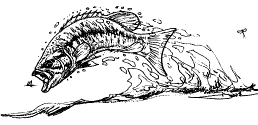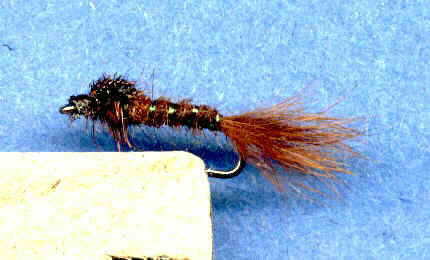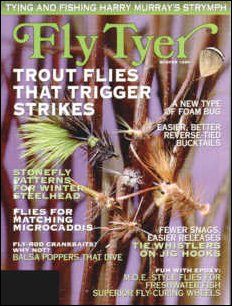
Check it Out

Headwaters:
a fish and angling art show
Here is a great selection of Hunting & Fishing magazines.
With 1200 Magazines to choose from you just can't go wrong
Help support this site by supporting our affiliates
All intellectual property and Pictures Copyright© of Robert Morger 1999. No reproductions of any material on this site is permitted without the express permission of the owner. All rights reserved.
The Onelist logo is a copyright of Onelist,Inc Copyright © 1998-1999, ONElist, Inc. All Rights
Reserved.
If you have suggestions or questions please contact rmorger@juno.com
Powered by counter.bloke.com
Parachute Skues Ant

| Colin McPherson P.S.Ant. This pattern is based loosely on the Skues's Ant pattern, which was
tied using chestnut coloured pigs wool. With Pigs wool being hard to obtain these days I
chose to use dyed hare instead. I chose to make it a parachute pattern simply because I
prefer them. The pattern is a representation of the queen ants that swarm in great clouds
on hot still days in July and August over the fields of Hampshire. Often the first
indication of their presence are flocks of seagulls, swifts and swallows, wheeling and
tumbling across the sky. The young queens have wings and disproportionately large
abdomens. I have only once witnessed a fall of ants on a river. The resulting feeding
frenzy has made me carry an ant pattern ever since. Tying Thread: Bennechi 8/0 tabacco. Tie the thread in at the head and run it down the shank an the back up to the one third point. Catch in a 4 inch length of poly propylene yarn in the middle with two turns of the thread. Then take both ends of the yarn and hold them vertically with you left (non - dominant) Hand. Pass the thread counter clockwise round the up stretched yarn in touching turns working your way up to form a wing post about 5 mm high (That's a little less than 1/4 of an inch for you non metric types.) and then down again to the hook. Trim the yarn so that the exposed portion is about 10 mm in length so that it doesn't get in the way. Put a drop of super glue at the base of the post. Make sure you don't put it on the exposed potion otherwise it will wick up through it. Prepare the Hackle with about 10 mm of clean stalk. Hold it in your right hand and tie the end of the stalk just to the left of the post then tie the hackle to the post by passing the thread around the post. The hackle should be pointing up and to the right. then run the silk to the rear of the fly. Wax the thread and dub on some hares fur. Form a nice rotund abdomen. Dub on a little more fur and pass the dubbed thread in a figure of eight around the base of the post. Wind the hackle clockwise down the Post using hackle pliers. Leave the hackle pliers dangling to the right an front of the post while you carefully pull the hackle fibres out of the way with you left hand and tie off with your right. Trim away the tip, then keeping the hackle fibres out of the way with your left hand again, form a nice neat head and whip finish. Put a little drop of varnish on the head. Trim the polypropylene wing to taste and tap it with your finger tip so that it flares. |

